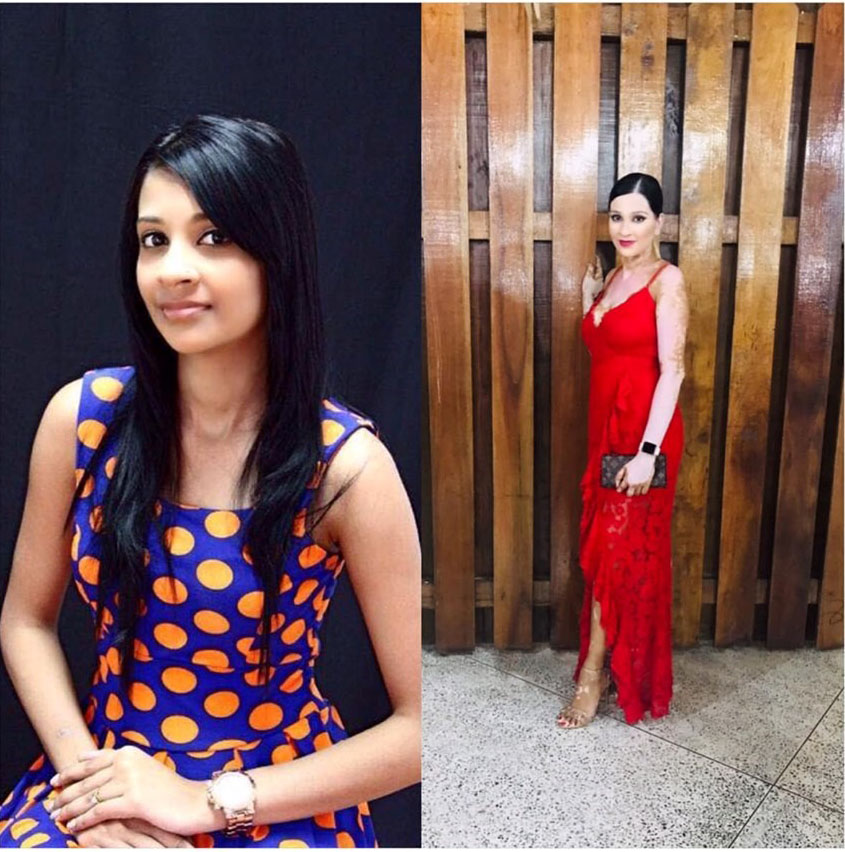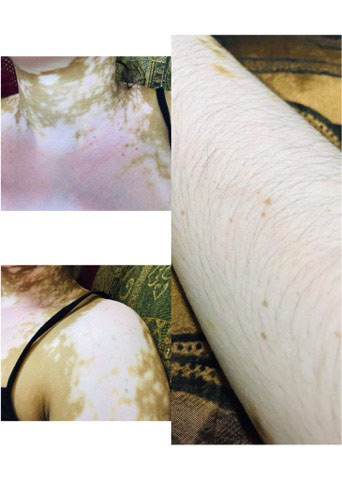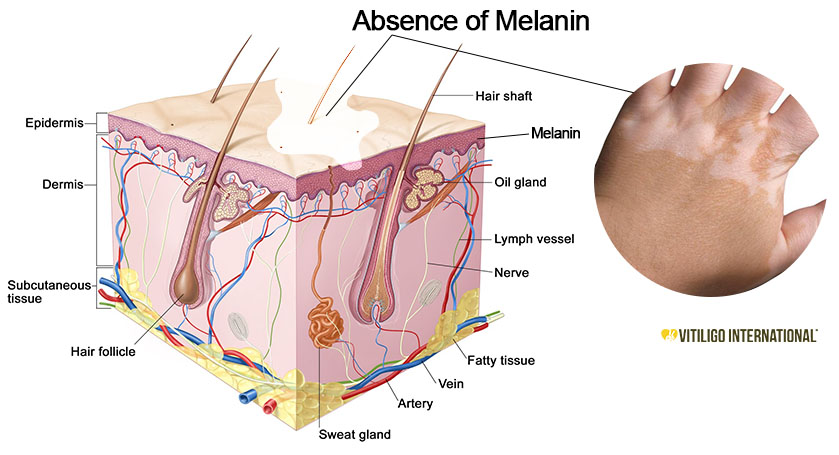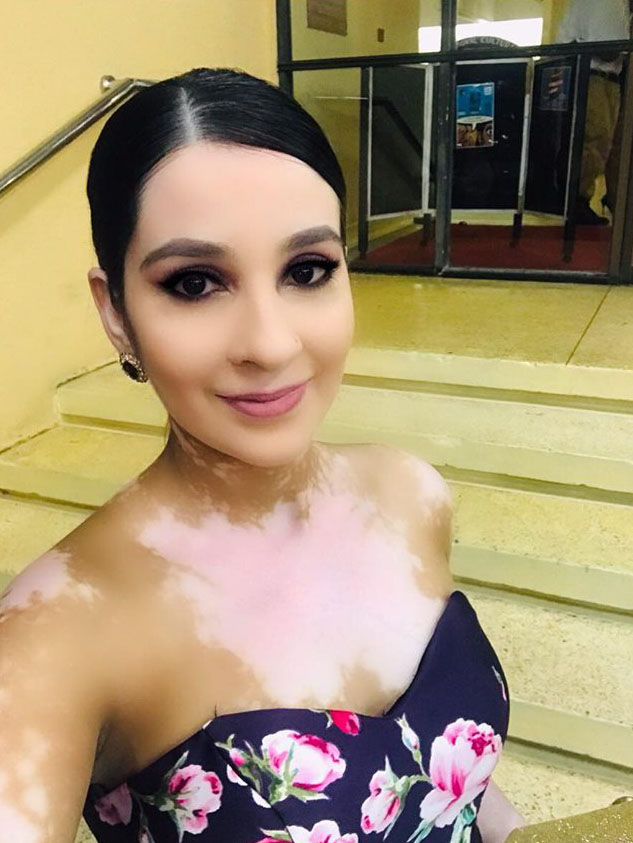https://www.stabroeknews.com/2...-skin-that-youre-in/
By Sharda Bacchus On
At age 18, Tashana Sasha Ramdeholl developed a “tiny” white spot on her face. It eventually got bigger and she now has white patches covering almost her entire body, including her face, hands and feet.
“After a while, from time to time, I notice like above my eyebrow and parts of my face, like different spots now on the face. But before it started like there were spots on my elbow, just little white spots but I didn’t take it for nothing, and then there were like spots on my toes that you could have seen,” Ramdeholl told Stabroek News.
Ramdeholl, 24, was subsequently diagnosed with Vitiligo (vit-ih-lie-go) – a rare skin condition that causes the skin to lose its normal pigment and develop pale marks.

According to the World Health Organization (WHO), Vitiligo is characterised by sharply defined areas of depigmentation, which occurs with an incidence of about 1% in most ethnic groups. The Mayo Clinic website entry on the condition explains that while normally the colour of hair and skin is determined by melanin, Vitiligo occurs when the cells that produce melanin die or stop functioning.
The disease affects both men and women and all age groups. Approximately 1 in 200 of the world population develops Vitiligo.
Ramdeholl said her hairdresser, who has the same skin condition, first noticed one of the spots and told her about Vitiligo.
“One day I was at the salon and she (hairdresser) looked at my toe because there were no other spots she could have seen. My face used to be covered in make up, so she would never know I had a spot. So she saw my toes and she was like ‘you know that’s Vitiligo’….and then she was like ‘I am telling you its Vitiligo. It’s the same thing that I have.’ And she say, ‘You know, just to clear your mind you should go visit the dermatologist,’” she recalled.
She eventually visited a dermatologist at Dr. Balwant Singh’s Hospital, where she was diagnosed.
“….I had to do tests like blood test, sugar test, all those tests but that wasn’t necessary to diagnose me because its just the outside that you need to see to be diagnosed with Vitiligo. There is nothing internally wrong with you, just the outside and I am losing the pigmentation. So the doctor turn the lights off and it reflects now in light and there is other spots that you wouldn’t normally see, that he can see with this kind of light, you call it a UV light. He can see that there are other spots waiting to come up,” she said.

The WHO says that Vitiligo can be managed with the use of camouflage cosmetics, which may help some patients to become socially integrated.
Additionally, exposure to ultraviolet irradiation after oral or topical pretreatment with therapy may induce a small degree of pigmentation. But this form of treatment, according to WHO, must be administered by trained dermatologists.
Ramdeholl said that she was eventually placed on treatment but after a while she decided to stop since she didn’t like te results she was seeing. “There were times when I had to take like more than 10 injections in the face alone and then the body, like the lower body parts was cream, and I just completely stop the treatment,” she said.
Daily challenges
On a daily basis, Ramdeholl said she is faced with a various challenges. However, as a “self motivator” she said she often comes up with remedies to overcome them.
For instance, Ramdeholl related that she was recently invited to attend a pageant and she noticed that she became self conscious about the white patches on her skin in the outfit that she decided to wear.
“I wore this red dress and I was feeling a bit self conscious. When I took a picture, my leg was showing and for some reason I just went into a depressed state… I start questioning myself, ‘Why me? Why can’t I have like one complexion? I can’t do this, I can’t do that,’” she said.

She added that the sun is another major challenge and she cannot spend more than 10 to 15 minutes outdoors.
“I can’t survive in the sun. I can’t go in and spend more than like 15 minutes,” Ramdeholl noted.
If she does, she said she experiences shortness of breath, dehydration and dizziness. “If I am going into the sun… I like outdoors, I use sunblock. I once tried it and I was severely burnt. I had blisters all over my skin and it was really bad,” she added.
Pigmentation protects the skin from the sun.
Ramdeholl related that as much as she is an “outdoor” person, she cannot go on adventures as she would like unless she spends most of the time in transporation or in accomodation with air conditioning.
‘Acceptance’
Many people living with Vitiligo have been stigmatised as a result of the condition.
However, Ramdeholl said she has chosen to be open about it. She noted that her appearance makes her the centre of attention whenever she goes outside but she has grown accustomed to it.
“…If I go here and I walk, the little children they will look at me…because I don’t cover it up… because this is my life whether or not I die today or tomorrow and this is who I am,” Ramdeholl said.
Importantly, she noted that no one has ever treated her differently as a result of the way she looks. “I can’t remember somebody coming to the shop or meeting somebody and they just telling me anything discriminitory,” she said.
“Basically it’s a part of life—that’s how I look at it like… I am still a normal woman and it’s there anybody I can help I would because its like I can do everything… this can never keep me down,” Ramdeholl added.
She explained that she spends a lot of time researching the ‘dos’ and ‘don’ts’ of living with Vitiligo.
Ramdeholl has also been seeking to use her experience to raise awareness about the skin condition. A lot of these, she said, involves the mental health effects on persons living with the conditon.
“….When I go to those [events], I would talk about it because people look at this as a downfall, it mentally attacks you then like you know if you have Vitiligo, some people can’t accept the fact that this is how they are going to look on the [outside], they take so much pride in buying all these nice make-up to cover,” she said.
Ramdeholl currently operates a beauty shop, Sasha’s Beauty Shop, which she established in order to get persons to embrace who they really are.
“…When people come to the shop and they tell me they want to cover a dark spot I am like ‘Why cover a dark spot?’ Look at my face, if I had to cover imagine what I would have gone through! It’s my entire body and you are just worried about a dark spot under your eyes? Makes no sense. You need to accept the fact that this is who you are and just move on,” she explained.
“I try to advise people, stop doing this, stop buying that, stop trying to make yourself look different for social media. Stop taking so much pride in the make-up you buy, you wear. Be you,” she added.
While there are treatments available to improve the colour of the white patches, Ramdeholl said she has refused to change her appearance. “I have learned to accept and express my skin, body and self as something beautiful instead of being shameful,” she said.

